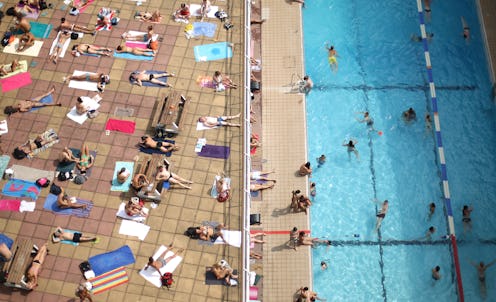Life
Can You Spot The Drowning Person In This Video?
We all know that summer is the season for hanging out in the pool and lounging on our inflatable swans as we sip mojitos and try to pretend we don’t know how disgusting swimming pools actually are. However, as this video of a lifeguard rescuing a drowning child shows, it’s important to remember that swimming pools (and other bodies of water) can be really dangerous, for kids especially. The CDC reports that 4,000 people die from drowning in the U.S. every year; in fact, it is the leading cause of death in children ages 1 to 4, after congenital problems.
The tricky thing about drowning is that in real life, it doesn’t look the way it does in the movies. On screen, drowning people flail around with their arms raised, screaming for help, but most real people are silent when drowning, with their arms in the water. For the untrained eye, the signs of drowning are easy to miss, even when parents and other adults are close by. In 2013, Slate reported that about half of children who drown do so “within 25 yards of a parent or other adult.” In the video below, we can see all too clearly that, even in a crowded pool, a child is not always safe. There are so many people in the water that watching for the drowning person is a bit like playing Where’s Waldo:
Fortunately, the lifeguard on duty has good eyes, and leaps to help. Within the space of a few seconds, she has him safe with his head above water.
This kid was lucky to have an observant lifeguard nearby, but we would all do well to know how to spot a drowning person. In an article for On Scene, Mario Vittone and Francesco A. Pia, Ph.D, explain that drowning people exhibit an “Instinctive Drowning Response,” which “represents a person's attempts to avoid the actual or perceived suffocation in the water.” This response doesn’t look like the screaming, flailing action we see on TV. Here are the real-life signs to look out for:
1. Most drowning people will not be able to call for help
People can only cry out for help if they are able to breathe. Most people who are drowning are unable to get their mouths above the surface of the water long enough to inhale and exhale, making speech of any kind out of the question.
2. A drowning person’s mouth will alternately move above and below the water’s surface
Vittone and Pia explain, “Drowning people’s mouths alternately sink below and reappear above the surface of the water.” When above the surface, they are struggling to inhale and exhale as quickly as possible.
3. A drowning person cannot wave his or her arms to signal that something is wrong
When people drown, they instinctively spread their arms away from their sides, horizontally, and press down, in order to push their mouths above the surface of the water.
4. A drowning person cannot make voluntary movements
Vittone and Pia explain that “Throughout the Instinctive Drowning Response, drowning people cannot voluntarily control their arm movements.” That means that they can’t swim toward you or toward shore, and they can’t grab onto rescue equipment. They need people to go out to them to help them get their heads above water.
5. A drowning person will be upright
A drowning person will stay upright in the water, unable to kick with his or her legs. Vittone explains in Slate that the person may “[a]ppear to be climbing an invisible ladder.”
Drowning people may also appear glassy-eyed, with their heads tilted backward and hair in their eyes or face. Vittone explains that, in fact, “Sometimes the most common indication that someone is drowning is that they don’t look like they’re drowning.” He suggests that if you see someone who appears to be treading water and looking upwards, ask if he or she is OK. If the person is able to respond, everything is probably fine. If they can’t, provide or seek help as quickly as possible.
Images: Getty (2); YouTube (2)
